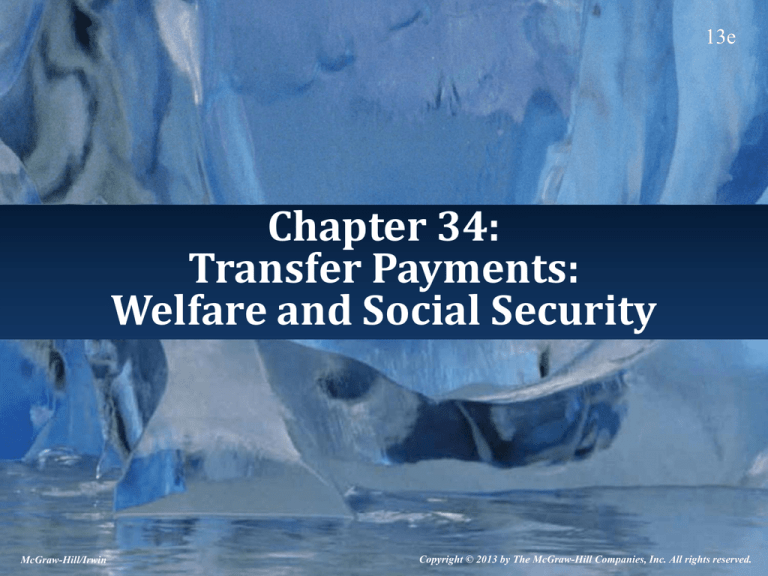
13e
Chapter 34:
Transfer Payments:
Welfare and Social Security
McGraw-Hill/Irwin
Copyright © 2013 by The McGraw-Hill Companies, Inc. All rights reserved.
Transfer Payments
• A transfer payment is paid out by
government to people who have been
determined to be eligible to receive the
payment.
– Legislation is passed authorizing these
payments.
– There is no exchange of goods or services.
34-2
Transfer Payments
• The principal recipients of transfer
payments are the elderly (Social Security,
for example) and the “poor” (welfare
payments), although any government
subsidy is a transfer payment.
34-3
Transfer Payments
• A transfer payment has a built-in incentive
for people to become eligible to receive it. It
is the “get something for nothing” or “free
ride” attitude.
34-4
Learning Objectives
• 34-01. Know the major income transfer
programs.
• 34-02. Know how transfer programs affect
labor supply and total output.
• 34-03. Know the trade-offs between equity
and efficiency.
34-5
Major Transfer Programs
• Payments can be in cash or in-kind
transfers.
– Cash transfer: a direct cash payout.
• Social Security and unemployment compensation.
– In-kind transfer: a payout of goods and services.
• Food stamps, Medicaid, housing subsidies.
34-6
Major Transfer Programs
• Programs can be social insurance programs
or welfare programs.
– Social insurance programs are triggered by
events.
• Reaching a certain age makes one eligible for Social
Security.
• Being fired from a job makes one eligible for
unemployment compensation.
– Welfare programs are means-tested. For
eligibility, a family has to prove it has too little
income.
34-7
Unintended Consequences
• Income transfers often change market
behavior and outcomes in unintended ways.
– If you get paid for not working, why work?
– Income transfers are a disincentive to work.
– If fewer people work, labor supply is reduced
and total output could shrink.
34-8
Unintended Consequences
• Income transfers often change market
behavior and outcomes in unintended ways.
– Nonwork behavior could be altered.
– Welfare payments could encourage women to
have more children.
– Teens might become mothers to qualify for a
welfare payment.
– “Free” health care tends to be overused,
congesting the waiting rooms of hospitals and
doctors.
34-9
Welfare Programs
• To identify potential recipients, the poverty
threshold was defined, based on how much
income is needed for families of different
sizes to buy basic necessities.
– For a family of four in 2010, the threshold was
about $22,000 a year.
– Thus a family of four earning $18,000 a year has
a poverty gap of $4,000.
34-10
Welfare Programs
• One way to “solve” the poverty problem
would be to identify all who are eligible and
provide a cash sum to eliminate every
poverty gap.
– Send $4,000 to the family previously mentioned.
34-11
Welfare Programs
• Problems:
• This provides a strong incentive to be poor.
– You make $25,000 working? Quit and get $22,000
without working.
• If you are already poor, does the welfare check
change your work behavior?
– You make $18,000 and get $4,000 in welfare. One of
the family members can earn $2,000 by working. If
she does, your welfare check drops to $2,000, and
your total income is still $22,000. Should she take
up this opportunity?
34-12
Welfare Programs
• Can these work disincentives be eliminated (or
reduced)?
– To provide incentives to take on work, welfare
payments would not bring the family up to the
poverty threshold.
– Another incentive is to not reduce welfare dollar for
dollar, so added work increases family income.
• In the example we just looked at, earn an extra
$2,000 and lose $2,000 in welfare. That is the
same as a 100% implicit marginal tax rate.
34-13
Welfare Programs
• The basic dilemma:
– Low implicit marginal tax rates encourage more work
effort but make more people eligible for welfare.
– High implicit marginal tax rates discourage work
effort but make fewer people eligible for welfare.
• Welfare costs can be minimized only if we sacrifice
welfare eligibility or sacrifice work incentives.
• One way to reduce welfare dependence is to limit
the amount of time a family will be eligible for
welfare. Time runs out? No more welfare
payments.
34-14
Social Security
• Age is the primary determinant of eligibility.
• The formula to calculate Social Security
benefits is skewed toward the low-income
worker.
– A higher-income worker will receive a larger
number of dollars in benefits, but, after
retirement, the ratio of payout between highand low-income workers will be smaller than
when they were working.
34-15
Social Security
• As you approach the age of eligibility for
Social Security payments, you make a
decision similar to a welfare recipient with a
job opportunity:
– Should I continue to work, or retire and collect
Social Security?
– Since the 1960s, the labor force participation
rate for men over 65 has been reduced by half.
34-16
Social Security
• This reveals a major cost of Social Security
programs.
– When workers retire early, there is a reduction
in total output.
– To reduce this cost, the practice of heavily
taxing Social Security benefits of those who are
eligible but still working could be eliminated.
Then the cost of working goes down.
34-17










